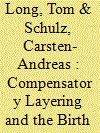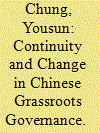| Srl | Item |
| 1 |
ID:
191904


|
|
|
|
|
| Summary/Abstract |
International organizations come in many shapes and sizes. Within this institutional gamut, the multipurpose multilateral intergovernmental organization (MMIGO) plays a central role. This institutional form is often traced to the creation of the League of Nations, but in fact the first MMIGO emerged in the Western Hemisphere at the close of the nineteenth century. Originally modeled on a single-issue European public international union, the Commercial Bureau of the American Republics evolved into the multipurpose, multilateral Pan American Union (PAU). Contrary to prominent explanations of institutional genesis, the PAU's design did not result from functional needs nor from the blueprints of a hegemonic power. Advancing a recent synthesis between historical and rational institutionalism, we argue that the first MMIGO arose through a process of compensatory layering: a mechanism whereby a sequence of bargains over control and scope leads to gradual but transformative institutional change. We expect compensatory layering to occur when an organization is focal, power asymmetries among members of that organization are large, and preferences over institutional design diverge. Our empirical and theoretical contributions demonstrate the value a more global international relations (IR) perspective can bring to the study of institutional design. international relations (IR) scholars have long noted that international organizations provide smaller states with voice opportunities; our account suggests those spaces may be of smaller states’ own making.
|
|
|
|
|
|
|
|
|
|
|
|
|
|
|
|
| 2 |
ID:
163714


|
|
|
|
|
| Summary/Abstract |
Since the retreat of the workplace system, Chinese cities have been presented with the important challenge of refurbishing local administrative systems at the sub-district level while meeting the emerging needs of new urban spaces. Building on new institutionalism concepts such as conversion and layering, this study examines conditions in Shanghai to ascertain what has made it a strong administrative city. The study discusses the development of Shanghai’s current local governance structure in terms of historical legacy, formal structure, and informal practices (i.e., two-tiered government and three-tiered management). This study also researches the complex state task of strengthening sub-district governance (so-called “community construction”) in urban China. The results of this study offer theoretical implications for institutional change and continuity related to these matters, thereby indicating that increased attention should be given to the agency-side explanation of endogenous institutional changes in the Chinese polity.
|
|
|
|
|
|
|
|
|
|
|
|
|
|
|
|
| 3 |
ID:
168802


|
|
|
|
|
| Summary/Abstract |
This article puts forward a historical institutionalist explanation of how rising powers translate increased wealth into military strength. It develops microfoundations for path dependence and applies them empirically as an approach to defense procurement. The Indian government layered market reforms onto a state-run defense sector. It aimed to exploit competition in its massive acquisition of combat fighter aircraft after 2007. Yet, despite formal rule changes and overwhelming material benefits, government reformers ultimately failed and returned to an intergovernmental purchase in 2015. I develop two mechanisms to explain this instance of failed institutional change in India. First, the reform's structural misfit created uncertainty, as some of the prerequisites for a market such as sound legal protection and private actors were absent. Second, the government reformers were reluctantly supported at the outset by a coalition of so-called opportunists, which neither fully embraced nor strongly opposed institutional reforms. When problems resulting from the misfit multiplied and promised benefits vanished, however, this coalition dissolved and layering failed. A process-tracing analysis and the triangulation of a diverse set of data substantiate this explanation. The article contributes to debates on institutional change as well as to those on rising powers and the constraints they face in their attempts to transform growing wealth into military strength. Most significantly, it specifies a causal pathway along which state institutions shape the defense policies of rising powers. Layered reforms may fail not only when faced by defenders of the status quo; opportunists may suffice to defeat them.
|
|
|
|
|
|
|
|
|
|
|
|
|
|
|
|